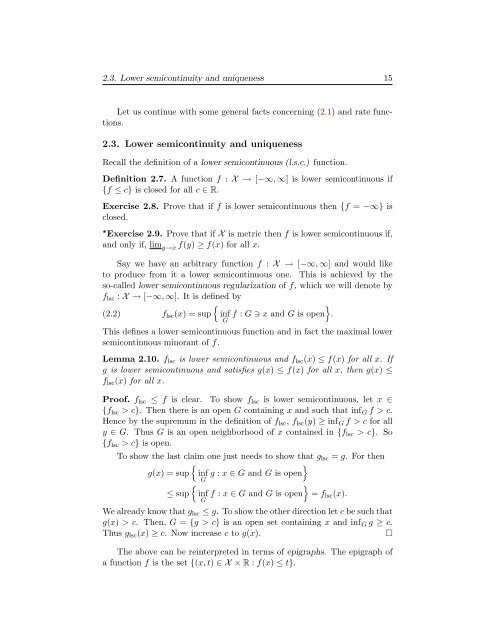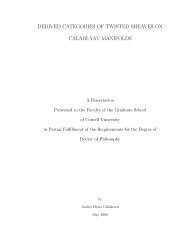A Course on Large Deviations with an Introduction to Gibbs Measures.
A Course on Large Deviations with an Introduction to Gibbs Measures.
A Course on Large Deviations with an Introduction to Gibbs Measures.
You also want an ePaper? Increase the reach of your titles
YUMPU automatically turns print PDFs into web optimized ePapers that Google loves.
2.3. Lower semic<strong>on</strong>tinuity <strong>an</strong>d uniqueness 15<br />
Let us c<strong>on</strong>tinue <strong>with</strong> some general facts c<strong>on</strong>cerning (2.1) <strong>an</strong>d rate functi<strong>on</strong>s.<br />
2.3. Lower semic<strong>on</strong>tinuity <strong>an</strong>d uniqueness<br />
Recall the definiti<strong>on</strong> of a lower semic<strong>on</strong>tinuous (l.s.c.) functi<strong>on</strong>.<br />
Definiti<strong>on</strong> 2.7. A functi<strong>on</strong> f : X → [−∞, ∞] is lower semic<strong>on</strong>tinuous if<br />
{f ≤ c} is closed for all c ∈ R.<br />
Exercise 2.8. Prove that if f is lower semic<strong>on</strong>tinuous then {f = −∞} is<br />
closed.<br />
∗ Exercise 2.9. Prove that if X is metric then f is lower semic<strong>on</strong>tinuous if,<br />
<strong>an</strong>d <strong>on</strong>ly if, lim y→x f(y) ≥ f(x) for all x.<br />
Say we have <strong>an</strong> arbitrary functi<strong>on</strong> f : X → [−∞, ∞] <strong>an</strong>d would like<br />
<strong>to</strong> produce from it a lower semic<strong>on</strong>tinuous <strong>on</strong>e. This is achieved by the<br />
so-called lower semic<strong>on</strong>tinuous regularizati<strong>on</strong> of f, which we will denote by<br />
flsc : X → [−∞, ∞]. It is defined by<br />
<br />
<br />
(2.2) flsc(x) = sup inf f : G ∋ x <strong>an</strong>d G is open<br />
G<br />
.<br />
This defines a lower semic<strong>on</strong>tinuous functi<strong>on</strong> <strong>an</strong>d in fact the maximal lower<br />
semic<strong>on</strong>tinuous minor<strong>an</strong>t of f.<br />
Lemma 2.10. flsc is lower semic<strong>on</strong>tinuous <strong>an</strong>d flsc(x) ≤ f(x) for all x. If<br />
g is lower semic<strong>on</strong>tinuous <strong>an</strong>d satisfies g(x) ≤ f(x) for all x, then g(x) ≤<br />
flsc(x) for all x.<br />
Proof. flsc ≤ f is clear. To show flsc is lower semic<strong>on</strong>tinuous, let x ∈<br />
{flsc > c}. Then there is <strong>an</strong> open G c<strong>on</strong>taining x <strong>an</strong>d such that infG f > c.<br />
Hence by the supremum in the definiti<strong>on</strong> of flsc, flsc(y) ≥ infG f > c for all<br />
y ∈ G. Thus G is <strong>an</strong> open neighborhood of x c<strong>on</strong>tained in {flsc > c}. So<br />
{flsc > c} is open.<br />
To show the last claim <strong>on</strong>e just needs <strong>to</strong> show that glsc = g. For then<br />
<br />
<br />
g(x) = sup inf g : x ∈ G <strong>an</strong>d G is open<br />
G<br />
<br />
<br />
≤ sup inf f : x ∈ G <strong>an</strong>d G is open = flsc(x).<br />
G<br />
We already know that glsc ≤ g. To show the other directi<strong>on</strong> let c be such that<br />
g(x) > c. Then, G = {g > c} is <strong>an</strong> open set c<strong>on</strong>taining x <strong>an</strong>d infG g ≥ c.<br />
Thus glsc(x) ≥ c. Now increase c <strong>to</strong> g(x). <br />
The above c<strong>an</strong> be reinterpreted in terms of epigraphs. The epigraph of<br />
a functi<strong>on</strong> f is the set {(x, t) ∈ X × R : f(x) ≤ t}.
















